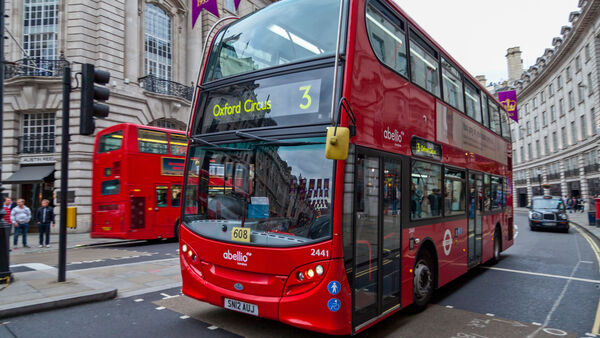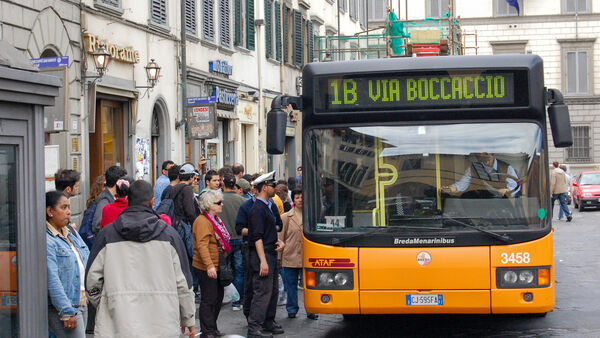Europe’s City Buses: Ride Like a Local


By Rick Steves
Most cities and towns in Europe have a public buses that, while designed primarily for locals' use, are often a great help to visitors. The travelers who shy away from them, feeling dauted by complicated schedules and routes, invariably waste time, stamina, and/or money.
Even in big cities with efficient subways, the bus can be a better option for some rides. Bus stops are more closely spaced than subway stops — meaning the bus is useful even for short hops, and usually gets you closer to where you need to go. Buses often go where the subway can't, such as the top of Castle Hill in Budapest. And since you're not underground, it's easier to stay oriented, see the landmarks, and enjoy the vibrant street life out the window. In fact, some public bus routes are downright scenic — Paris' bus #69 gives you a great sightseeing introduction for just the cost of a transit ticket.
In bigger cities, buses run frequently enough, especially during peak hours, that you can just arrive at a stop without much risk of a long wait (many stops have electronic signs noting how many minutes until the next bus arrives). Although night buses run less frequently and follow limited routes, they're useful for night owls who don't want to spring for a taxi.
But local buses have long presented travelers with challenges: Unlike subway and tram cars, they aren't confined to the route determined by a track, leading to an understandable sense that, in an unfamiliar locale, you could accidently find yourself far off course, or even stranded. Meanwhile, it's hard to know which buses will take you where. Whereas schematic route maps of subway and tram lines are usually easy to grasp (as even the biggest cities have a relatively small number of lines), bus-network maps are often a visually chaotic, confusing-feeling mess. And since buses usually don't run as frequently as subway lines, riders need to pay attention to schedules lest they waste time idling at bus stops.
The good news: Thanks to huge improvements in mapping apps, anyone traveling with a connected mobile device can now skip most of these headaches. I've always considered Europe's city buses worth the hassle, but now that my phone gives me step-by-step instructions for getting from A to B by the fastest/easiest route, the hassle is all but gone. With my phone's help, buses have become a joy.
The only major downside of city buses not solved by a good app: They're slowed down by traffic — try to avoid taking them during rush hour.
Tips for Making Europe's City Buses a Breeze
Use a mapping app… It's hard to overstate how much mapping apps have improved the experience of navigating city-bus systems — a huge boon for travelers. Citymapper is my go-to in the places it covers (the list includes most of Europe's biggest cities), but most any mapping app has great information for transit riders.
…or get bus schedules in advance. If you're traveling without the internet in your pocket, pick up a bus map and schedule from the local tourist or transit office, or check the bus system's website for schedules before heading out for the day. Many bus stops have their routes and timetables posted — taking photos of any schedules you might want later. (On a round-trip ride, give your return ride some thought as you step off the bus: Look for the stop you'll use for your return trip — it may well be right across the street — and note the departure times, if posted there, of your return bus.)
Confirm the essentials before you board. Find out if you need to have a ticket in advance or if you can buy it on the bus (if you buy it from the driver, you'll usually need exact change). Make sure you're getting on the right bus going in the right direction. Before you get on, mention your destination to a local or the driver. Smile and ask, for example, "Vaticano?"
Validate your ticket. Usually you enter at the front of the bus and show your ticket to the driver, or validate it by inserting it into an automated time-stamp box. Observe and imitate what the locals do.
Get off at the right stop. Bus stops, like subway stops, are named (usually for a cross street or nearby landmark), but their names are often difficult to see from a moving bus. Most buses have electronic signs that announce the next stop. If they don't, it can be tricky to get off where you intend, so it pays to stay alert. Have a sense of how long a ride is going to take, and know the names of the stops coming up right before yours (and the one right after yours, so you'll know if you've gone too far). If possible, sit near the door, so you can hop out easily. On a cross-town trip, you'll have time to enjoy the sights. As you ride, follow along the route on your map, looking for landmarks along the way: monuments, bridges, major cross streets, and so on. If you're uncertain about your stop, get the attention of the driver or another passenger and ask, "Prado?" (For extra credit, preface your request with the local word for please.) Then wait for them to signal to you when the bus reaches the Prado.
In bike-friendly cities such as Amsterdam and Copenhagen, buses often let passengers off directly into busy bicycle lanes. Look carefully, in both directions, as you exit.
Signal for your stop. Some buses pull over at every stop, while others only stop by request; this means you can't necessarily navigate by counting stops. If in doubt, look for a pull cord or a button with the local word for "stop," and use it to signal that you want to get off at the next stop.
Stick to public buses. In many cities, privately operated hop-on, hop-off tourist buses connect the major sights. Riding these for the entire loop route can be a fun, easy way to get oriented in a new city — but these buses are almost always a bad option for actually getting around town. With simple, cartoon-colored route maps and regular-interval schedules, they tempt many tourists who feel intimidated by the public-bus system. Give yourself some credit, and take the city bus — you'll save money and have a wider range of options, while enjoying the kind of rich people-watching and cultural eavesdropping no tourist bus could offer.

